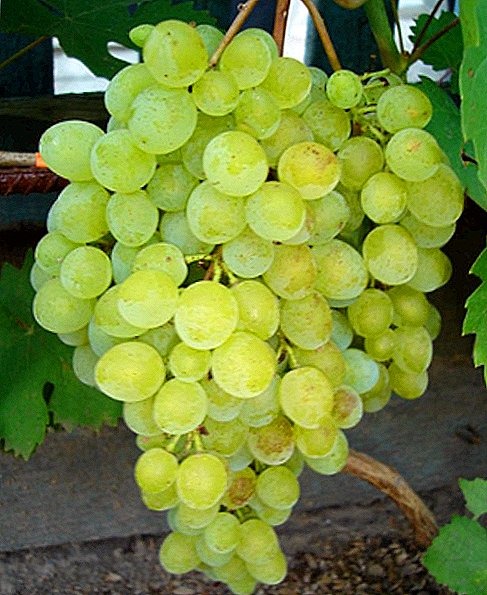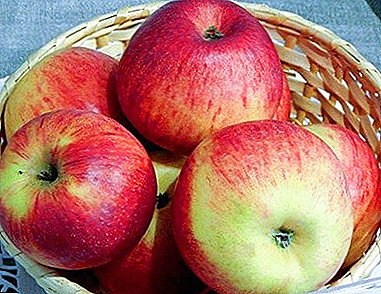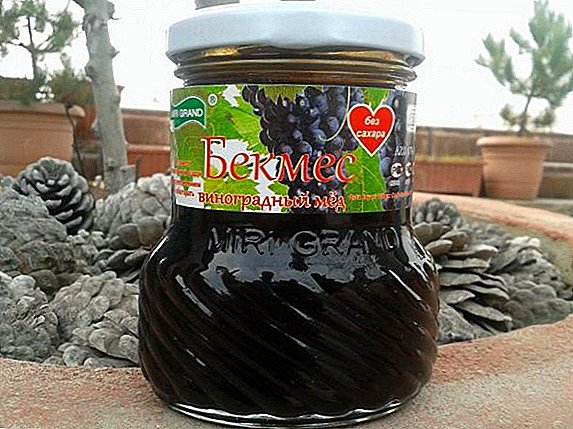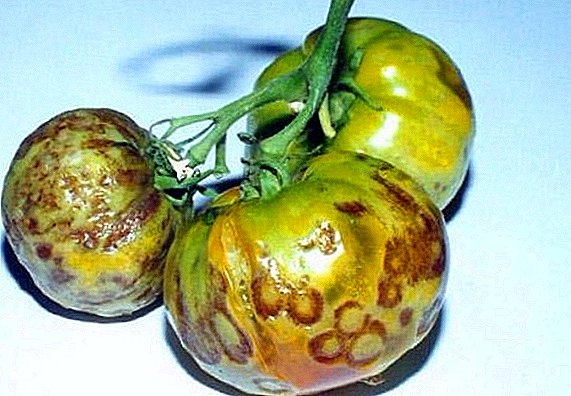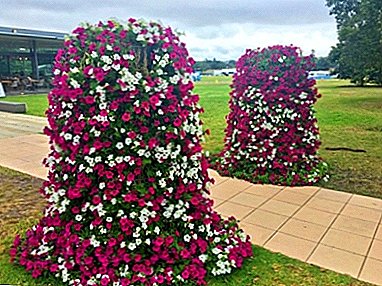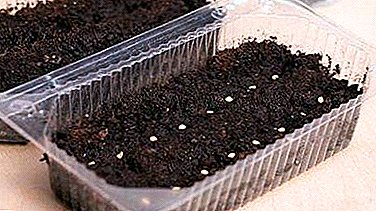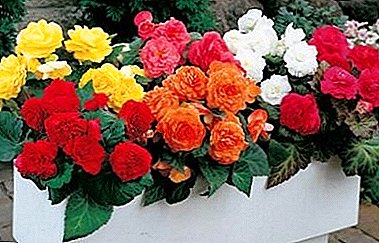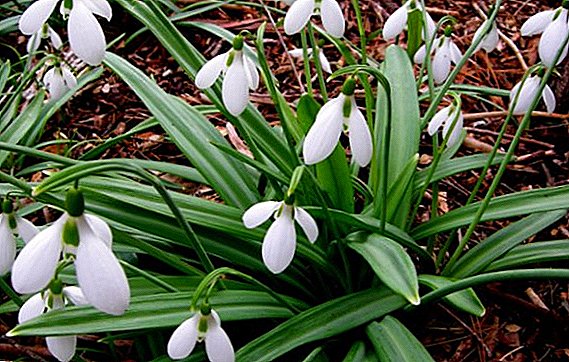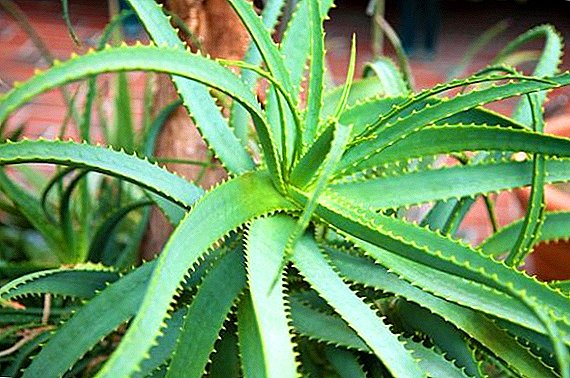 Aloe is probably the most common type of vegetation in the homes of our compatriots. This houseplant can rightly be called a home emergency, because aloe is used for many ailments and it rarely needs a detailed description. "Grandmother's recipes" on the use of aloe probably more than once rescued each of us, so this plant can not be confused with any other: razlie fleshy leaves, pleasant color and faint smell.
Aloe is probably the most common type of vegetation in the homes of our compatriots. This houseplant can rightly be called a home emergency, because aloe is used for many ailments and it rarely needs a detailed description. "Grandmother's recipes" on the use of aloe probably more than once rescued each of us, so this plant can not be confused with any other: razlie fleshy leaves, pleasant color and faint smell.
What aloe choose for home, the most common indoor varieties
The homeland of aloe is the Arabian Peninsula, and in nature there are about 400 species of these plants, although not all of them can grow in the home. When buying aloe, you will be advised those varieties that are best suited for the home, among them:
- Aloe tree, more popularly known as the "agave". In this species, the leaves are longer (20-25 centimeters). They are fleshy, razlohe and through them can be seen the stem. Along the edges of the "circled" teeth and can reach a height of 1 meter.

- Aloe "tiger". The stem of this plant is very short and it is almost invisible. The leaves are short, bright green with white stripes, folded along the stem in a spiral fashion. Very often, due to the appearance of "tiger" aloe is confused with Gaster: it has no "cloves" and is capable of flowering.
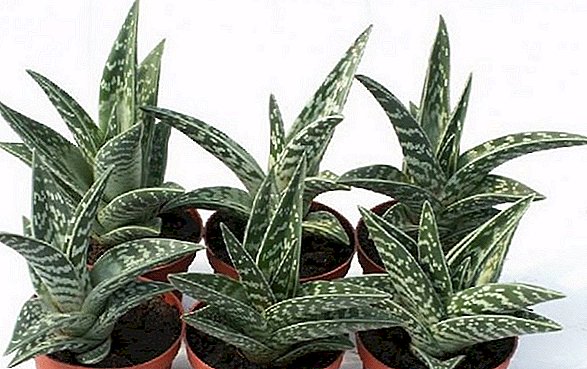
- Aloe vera (Aloe Vera). The leaves of this type of lanceolate form, are painted green with a smoky shade and teeth on the edges. They reach 50 centimeters in length and are located rosettes on a short stalk. This species may bloom (long spike with several inflorescences, and the flower itself is yellow). Some varieties of Aloe Vera may have a color with a red color.
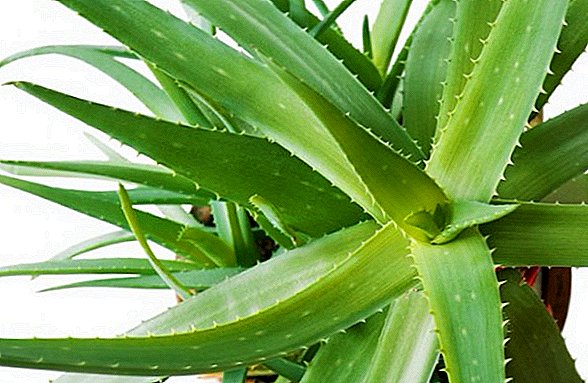
- Aloe frightening - quite a large plant, which in natural conditions can reach up to 3 meters in height. The leaves of this species are fleshy and large - up to 50 centimeters in length and 15 centimeters wide and “fold” into rosettes (a bright orange flower with a red tint appears from the middle of the rosette). Interestingly, the leaves can take on a reddish hue, and the cloves can grow throughout its area.
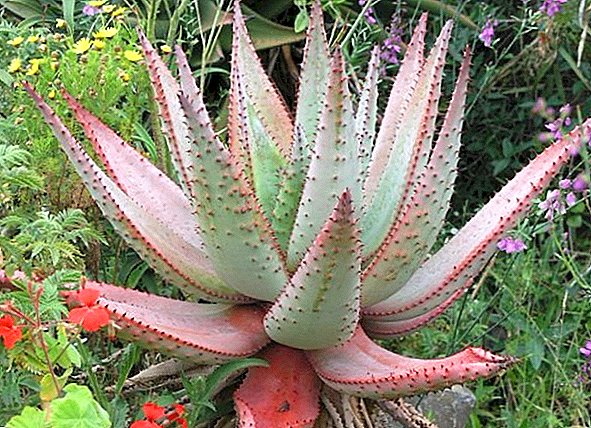
- Aloe soap - a representative with a stem that "winds." The leaves of this species are rather large (60: 6), flat and curved. Usually the plant is not one, but several sheet rosettes. The leaves are "decorated" with white spots, and the cloves grow on the rim of the sheet. Such plants are characterized by a cuspid inflorescence of yellow color with a red tinge.
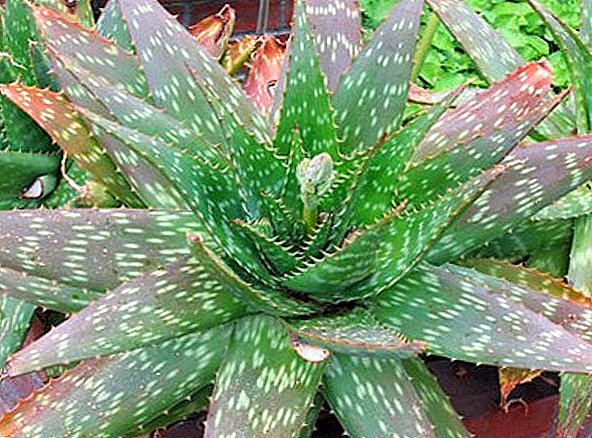
What place to pick for aloe
In order to choose the right place for planting aloe, it is necessary to take into account its natural habitat, temperature conditions and lighting, since only under such circumstances will the care of aloe be correct. Like the rest of the succulents, this plant loves well-lit places, so all window sills that go to the south are perfect for its “life”. If the plant will get direct sunlight - this is not a problem, because it tolerates them very well.
 The ideal temperature for growing aloe can vary with the seasons: in winter, the optimal temperature indicators are + 10 ... 15 ° C, and in summer, the plant can be kept at room temperature. Many flower growers are advised to take aloe to the balcony (in the yard) for the summer, but this should be done gradually, first leaving it only for 1 hour.
The ideal temperature for growing aloe can vary with the seasons: in winter, the optimal temperature indicators are + 10 ... 15 ° C, and in summer, the plant can be kept at room temperature. Many flower growers are advised to take aloe to the balcony (in the yard) for the summer, but this should be done gradually, first leaving it only for 1 hour.
Important! In winter, the plant may require additional lighting, which can be provided with fluorescent lamps.
Features planting medicinal plants
For the proper cultivation of the present and the simplicity of further care it is important to follow all the rules when planting a plant. The process itself is not complicated, however, there are some subtleties that still need to be considered.
What should be the soil
 The main thing you need to know when choosing soil for aloe is that it should be fertile and loose (for good aeration of the soil). If your soil is not loose enough, it can be loosened in the process of watering. For planting aloe, you can buy ready-made substrate, and you can cook it yourself. In the latter case, you will need: soddy-clay soil, which is mixed with leaf soil and dry sand in a ratio of 2: 1: 1. Mandatory for aloe is the presence of drainage, which can serve as expanded clay.
The main thing you need to know when choosing soil for aloe is that it should be fertile and loose (for good aeration of the soil). If your soil is not loose enough, it can be loosened in the process of watering. For planting aloe, you can buy ready-made substrate, and you can cook it yourself. In the latter case, you will need: soddy-clay soil, which is mixed with leaf soil and dry sand in a ratio of 2: 1: 1. Mandatory for aloe is the presence of drainage, which can serve as expanded clay.
Did you know? The function of drainage can be performed by charcoal, previously crushed.A very important point is to maintain optimum soil moisture.
Landing pattern
Aloe planting scheme is very simple and consists of the following steps:
- Preparation of earth mixture and drainage.
- Laying out the drainage at the bottom of the pot, backfilling of the earth mixture for 2/3 of the tank, and its hydration.
- Laying dry, pre-calcined sand.
- Planting of planting material (it is slightly buried in the main ground mass).
- Moisturizing the soil with water.
How to properly care for aloe
In order for aloe to feel comfortable on your windowsill, care at home should consist of several factors: proper and timely watering, quality feeding, accurate transplanting and pruning. 
Irrigation and spraying mode
Watering mode depends on the time of year. In the summer, it should be more abundant (it is worth watering as the soil dries, it will be enough 1-2 times a week). In winter, the plant goes "at rest" and the introduction of fluid is minimized. Aloe doesn’t like stagnant water, so it’s worth watering around the pot, or lowering the plant into water for 10-15 minutes. With the stagnation of water in the leaves, the plant may die. Also, the liquid should not stand in the pan for long. For watering should choose soft water, room temperature.
Did you know? Aloe, most often, dies from overflow, while underfilling is perceived by them much more easily.It is enough to spray the pot once a week, but the spray gun should be at a distance of 30-50 centimeters from the plant, in order to avoid the aforementioned stagnation of water.
How to feed aloe
Aloe does not need a special top-dressing, because with the right watering it develops well by itself, however, the plant absorbs monthly “preventive” top-dressings well. Fertilizing is carried out from mid-spring until the end of autumn, it is best done with mineral fertilizers and eco-fertilizers. In winter, during the rest period, it is not necessary to feed the plant.
Pruning plants
 When deciding how best to form aloe, it is necessary to understand that all the methods used in this case are somewhat different from the methods of forming other plants, because the structure of the leaf and the stem also has certain differences. In order to properly prune this plant should follow 5 simple rules. The first thing that is important to notice when pruning is taking care of the health of the plant. You should always remove all dried or at least slightly damaged leaves, since it is in the "sick" parts of the plant that many bacteria develop. It is impossible not to take into account the fact that the sun aloelyubit, and therefore care will be to remove the leaves that interfere with the access of light.
When deciding how best to form aloe, it is necessary to understand that all the methods used in this case are somewhat different from the methods of forming other plants, because the structure of the leaf and the stem also has certain differences. In order to properly prune this plant should follow 5 simple rules. The first thing that is important to notice when pruning is taking care of the health of the plant. You should always remove all dried or at least slightly damaged leaves, since it is in the "sick" parts of the plant that many bacteria develop. It is impossible not to take into account the fact that the sun aloelyubit, and therefore care will be to remove the leaves that interfere with the access of light.
The second and very important rule is the correct pruning of a plant. The sheet is cut with a sharp knife at the base. Usually cut off the most extreme sheets, as they are already old and matured. They can be used for personal purposes.
The third step in pruning is controlling the size of the plant. If it has many new shoots, it is better to remove them, since they take the power from the root. Such parts are removed by pulling from the root, when they have already reached 5-6 centimeters in length.
 The fourth condition for quality pruning is to preserve the natural color of the pot as much as possible. After the plant has faded, the oldest leaves need to be removed, however, given that not all varieties are blooming, growers rarely encounter this problem. And the last, but not the most insignificant factor is the cutting of aloe roots. During the transplant, examine the root system and cut the longest roots. This will help the growth of a new, healthy root system.
The fourth condition for quality pruning is to preserve the natural color of the pot as much as possible. After the plant has faded, the oldest leaves need to be removed, however, given that not all varieties are blooming, growers rarely encounter this problem. And the last, but not the most insignificant factor is the cutting of aloe roots. During the transplant, examine the root system and cut the longest roots. This will help the growth of a new, healthy root system.
When is it required and how to perform the transplant
The root system of aloe develops quite quickly and therefore, from time to time the plant requires transplantation. Depending on the age of aloe, it needs to be replanted either annually (young plants) or every other year (for older plants). Transplant is carried out in a pot, which will be 1.5 times the previous one.
Many people ask: "Can aloe be transplanted in the fall?". Florists categorically do not recommend this, because in the fall the plant begins to “fall asleep” and the pot does not have time to adapt to a new place of “residence”.
Important! If you do not have the opportunity to prepare the substrate necessary for comfortable growth, you can use a ready-made mixture for cacti, the main thing is drainage.
Reproduction aloe, the main ways
Aloe has long become one of the most popular plants on domestic window sills, thanks in large part to different breeding methods.
Sowing aloe
Seed propagation is a rather laborious process. Seeds are sown in late February or early March, at room temperature. Strongly bury them do not need, just enough to gently push into the previously prepared substrate. Seedlings should dive into small, shallow boxes and contain these containers at a temperature of + 21 ° C, preferably under a lamp. After they germinate, it is necessary to transplant the processes in the pots, and a year later to conduct another transplant.

Did you know? The sowing of aloe seeds is similar to the sowing of cactus seeds.
Aloe cutting
Aloe can be propagated by cuttings all year round, but it is better to conduct cuttings in the summer. The cuttings grow along the stem, and they should be cut at the very base. After cutting, the resulting material is dried on a flat, sterile surface for 5 days, placing it in a dark room. The place from which the cuttings are cut is necessary to “wipe” with coal.
 Cuttings are planted in the sand, at a short distance of 3-5 centimeters, because only in this case the root system of the future pot will develop correctly. It is not necessary to bury the cuttings deeply, 1 cm is enough, but humidity plays an important role, therefore it is constantly maintained (when the first roots appear, watering should be strengthened even more). A month later, the grown cuttings can be transplanted into small pots for flowers, into a prepared mixture.
Cuttings are planted in the sand, at a short distance of 3-5 centimeters, because only in this case the root system of the future pot will develop correctly. It is not necessary to bury the cuttings deeply, 1 cm is enough, but humidity plays an important role, therefore it is constantly maintained (when the first roots appear, watering should be strengthened even more). A month later, the grown cuttings can be transplanted into small pots for flowers, into a prepared mixture.
Reproduction shoots and basal shoots
Breeding shoots - the way that you can use when breeding any plant.
Important! In order to choose an escape, you need to be able to distinguish it from the parent sheet. The shoots have thin leaves and without spines.
 Even in a young plant, shoots are very “tenacious” and are able to take root quickly and efficiently. For breeding shoots it must be carefully cut, dried and planted in the already prepared substrate (used the same as for planting). Before direct planting, cut with coal. It is advisable to reproduce shoots in spring or early summer. The shoot takes root within a month, and after that it is looked after as an adult plant.
Even in a young plant, shoots are very “tenacious” and are able to take root quickly and efficiently. For breeding shoots it must be carefully cut, dried and planted in the already prepared substrate (used the same as for planting). Before direct planting, cut with coal. It is advisable to reproduce shoots in spring or early summer. The shoot takes root within a month, and after that it is looked after as an adult plant.
The propagation of the closet shoots is very important at home, however, it is better to use this method as an experienced florist. Bottom growth is also called "baby". Children grow near the root and by themselves develop their root system. In order to use this method, you just need to carefully dig up the "baby" and transplant in the finished substrate.
As you can see, aloe does not require special care and it is a pleasure to grow it on your windowsill, because the beneficial properties contained in this plant can serve you well in treating many diseases (this plant is especially effective for colds). And who does not want to grow at home "green doctor".







